Project Management Capstone: Scrum Principles, Agile & Implementation
VerifiedAdded on 2023/06/14
|24
|3975
|272
Report
AI Summary
This project management capstone report provides an in-depth analysis of Scrum principles, including empirical process control (transparency, inspection, adaptation), self-organization, collaboration, value-based prioritization, time-boxing, and iterative development. It compares Scrum with traditional project management methods and explores the challenges of Agile and hybrid implementation, focusing on scalability and change management. The report also discusses processes for implementing change management and contrasts the challenges of change management with Scrum versus the Waterfall model. The document concludes by highlighting the importance of adapting to change and continuous improvement in project management. Desklib offers a wealth of similar resources for students.

Running head: PROJECT MANAGEMENT CAPSTONE
Subject Name: Project Management Capstone
Student Name: Jaspreet Kaur Atwal
Student ID: 00167655T
Subject Name: Project Management Capstone
Student Name: Jaspreet Kaur Atwal
Student ID: 00167655T
Paraphrase This Document
Need a fresh take? Get an instant paraphrase of this document with our AI Paraphraser
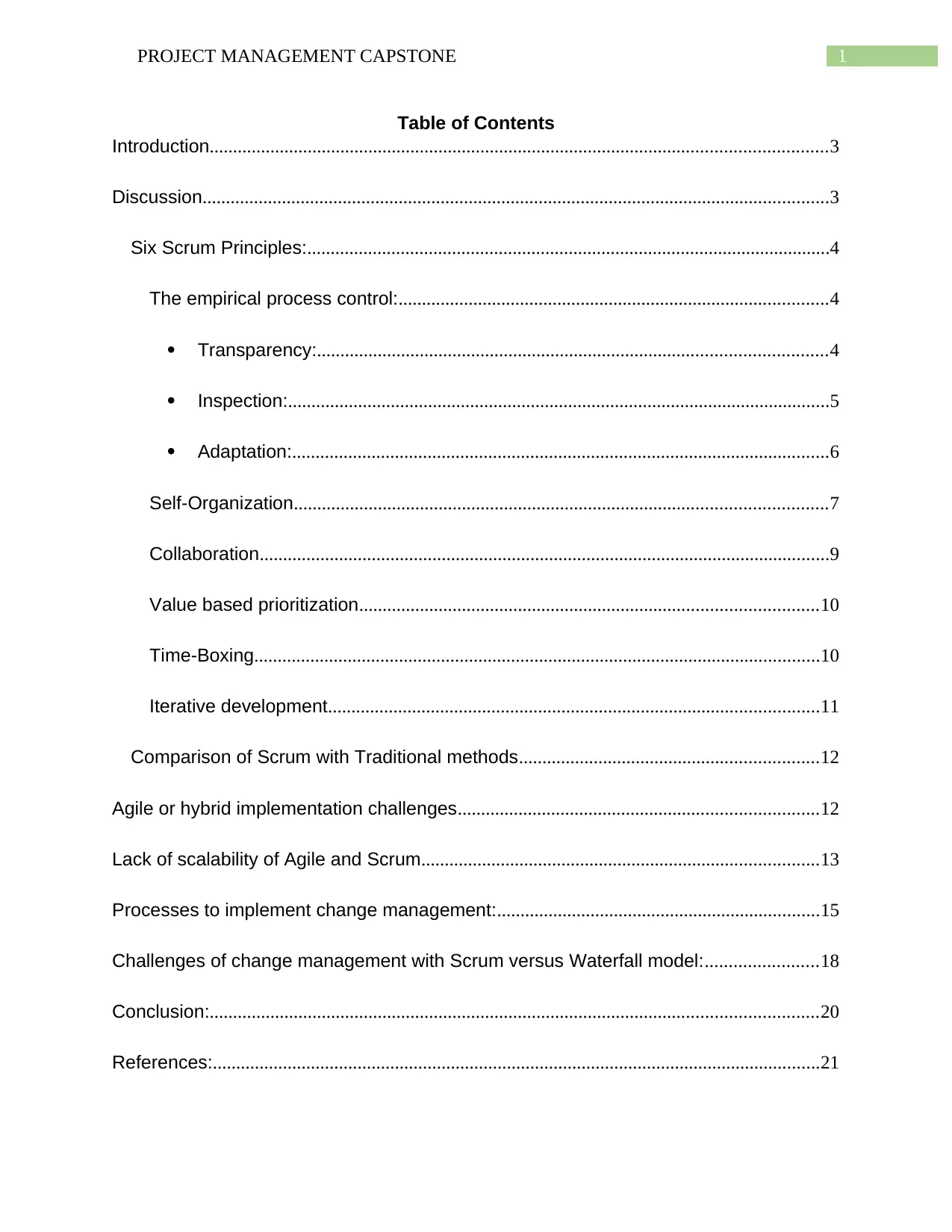
1PROJECT MANAGEMENT CAPSTONE
Table of Contents
Introduction....................................................................................................................................3
Discussion......................................................................................................................................3
Six Scrum Principles:................................................................................................................4
The empirical process control:............................................................................................4
Transparency:.............................................................................................................4
Inspection:....................................................................................................................5
Adaptation:...................................................................................................................6
Self-Organization..................................................................................................................7
Collaboration..........................................................................................................................9
Value based prioritization..................................................................................................10
Time-Boxing.........................................................................................................................10
Iterative development.........................................................................................................11
Comparison of Scrum with Traditional methods................................................................12
Agile or hybrid implementation challenges.............................................................................12
Lack of scalability of Agile and Scrum.....................................................................................13
Processes to implement change management:.....................................................................15
Challenges of change management with Scrum versus Waterfall model:........................18
Conclusion:..................................................................................................................................20
References:..................................................................................................................................21
Table of Contents
Introduction....................................................................................................................................3
Discussion......................................................................................................................................3
Six Scrum Principles:................................................................................................................4
The empirical process control:............................................................................................4
Transparency:.............................................................................................................4
Inspection:....................................................................................................................5
Adaptation:...................................................................................................................6
Self-Organization..................................................................................................................7
Collaboration..........................................................................................................................9
Value based prioritization..................................................................................................10
Time-Boxing.........................................................................................................................10
Iterative development.........................................................................................................11
Comparison of Scrum with Traditional methods................................................................12
Agile or hybrid implementation challenges.............................................................................12
Lack of scalability of Agile and Scrum.....................................................................................13
Processes to implement change management:.....................................................................15
Challenges of change management with Scrum versus Waterfall model:........................18
Conclusion:..................................................................................................................................20
References:..................................................................................................................................21

2PROJECT MANAGEMENT CAPSTONE
⊘ This is a preview!⊘
Do you want full access?
Subscribe today to unlock all pages.

Trusted by 1+ million students worldwide
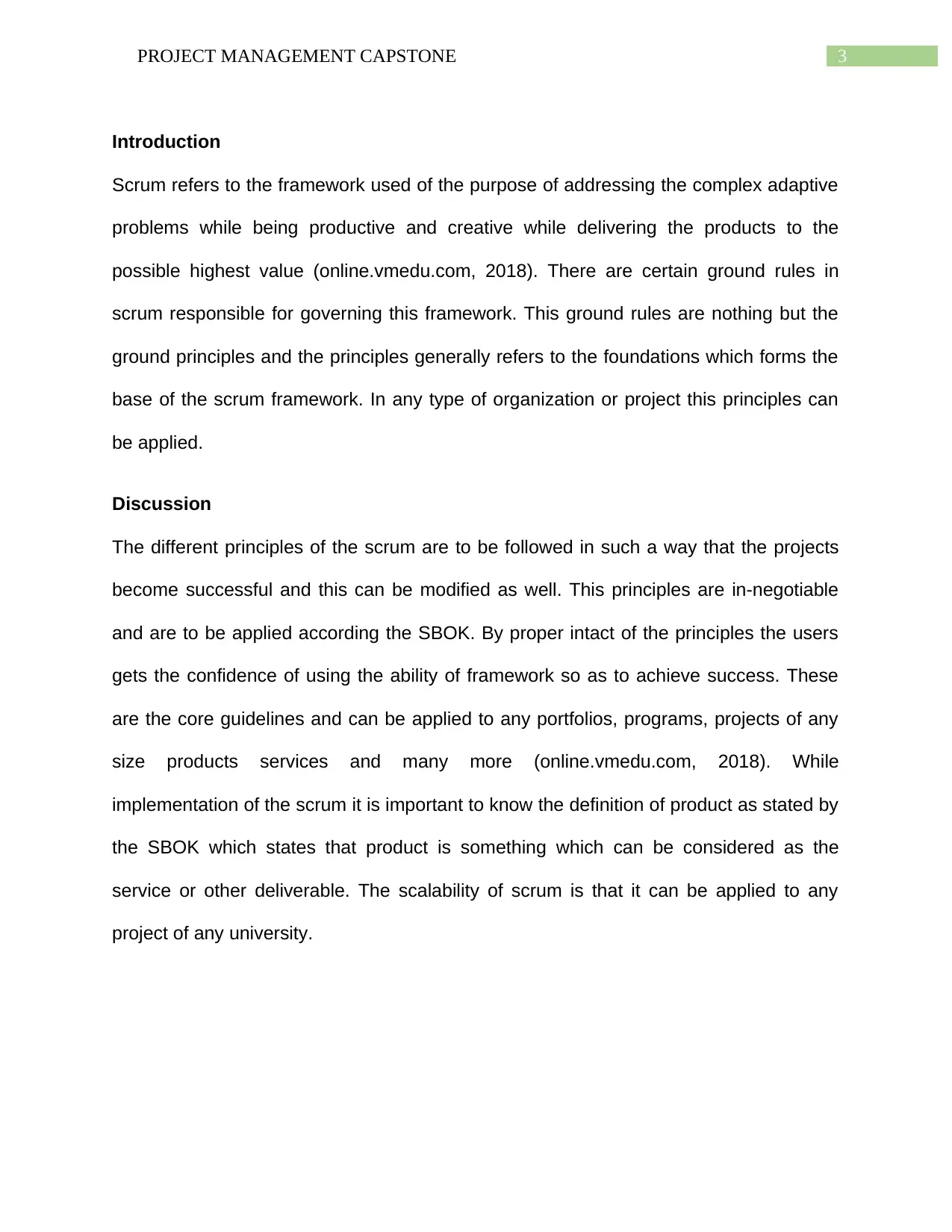
3PROJECT MANAGEMENT CAPSTONE
Introduction
Scrum refers to the framework used of the purpose of addressing the complex adaptive
problems while being productive and creative while delivering the products to the
possible highest value (online.vmedu.com, 2018). There are certain ground rules in
scrum responsible for governing this framework. This ground rules are nothing but the
ground principles and the principles generally refers to the foundations which forms the
base of the scrum framework. In any type of organization or project this principles can
be applied.
Discussion
The different principles of the scrum are to be followed in such a way that the projects
become successful and this can be modified as well. This principles are in-negotiable
and are to be applied according the SBOK. By proper intact of the principles the users
gets the confidence of using the ability of framework so as to achieve success. These
are the core guidelines and can be applied to any portfolios, programs, projects of any
size products services and many more (online.vmedu.com, 2018). While
implementation of the scrum it is important to know the definition of product as stated by
the SBOK which states that product is something which can be considered as the
service or other deliverable. The scalability of scrum is that it can be applied to any
project of any university.
Introduction
Scrum refers to the framework used of the purpose of addressing the complex adaptive
problems while being productive and creative while delivering the products to the
possible highest value (online.vmedu.com, 2018). There are certain ground rules in
scrum responsible for governing this framework. This ground rules are nothing but the
ground principles and the principles generally refers to the foundations which forms the
base of the scrum framework. In any type of organization or project this principles can
be applied.
Discussion
The different principles of the scrum are to be followed in such a way that the projects
become successful and this can be modified as well. This principles are in-negotiable
and are to be applied according the SBOK. By proper intact of the principles the users
gets the confidence of using the ability of framework so as to achieve success. These
are the core guidelines and can be applied to any portfolios, programs, projects of any
size products services and many more (online.vmedu.com, 2018). While
implementation of the scrum it is important to know the definition of product as stated by
the SBOK which states that product is something which can be considered as the
service or other deliverable. The scalability of scrum is that it can be applied to any
project of any university.
Paraphrase This Document
Need a fresh take? Get an instant paraphrase of this document with our AI Paraphraser
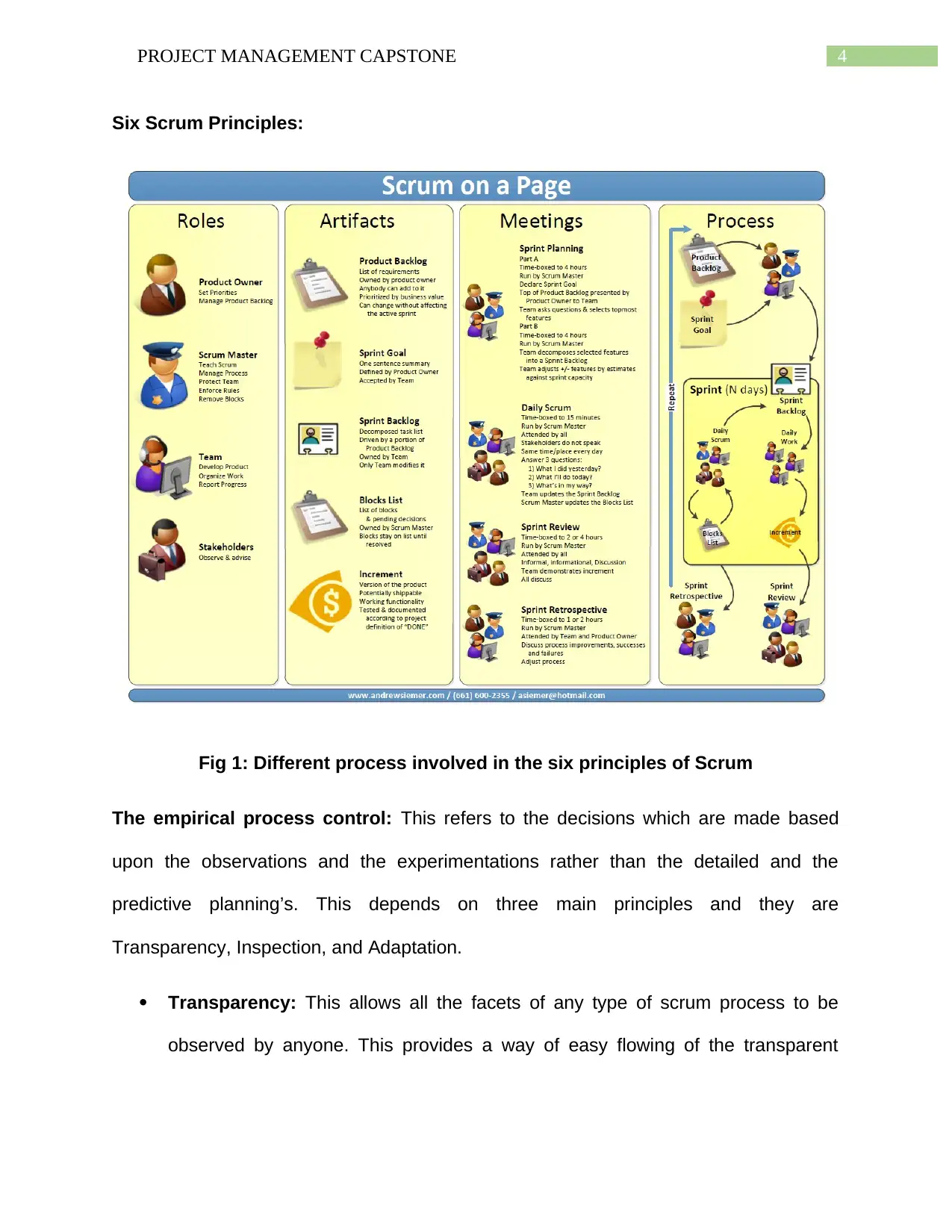
4PROJECT MANAGEMENT CAPSTONE
Six Scrum Principles:
Fig 1: Different process involved in the six principles of Scrum
The empirical process control: This refers to the decisions which are made based
upon the observations and the experimentations rather than the detailed and the
predictive planning’s. This depends on three main principles and they are
Transparency, Inspection, and Adaptation.
Transparency: This allows all the facets of any type of scrum process to be
observed by anyone. This provides a way of easy flowing of the transparent
Six Scrum Principles:
Fig 1: Different process involved in the six principles of Scrum
The empirical process control: This refers to the decisions which are made based
upon the observations and the experimentations rather than the detailed and the
predictive planning’s. This depends on three main principles and they are
Transparency, Inspection, and Adaptation.
Transparency: This allows all the facets of any type of scrum process to be
observed by anyone. This provides a way of easy flowing of the transparent
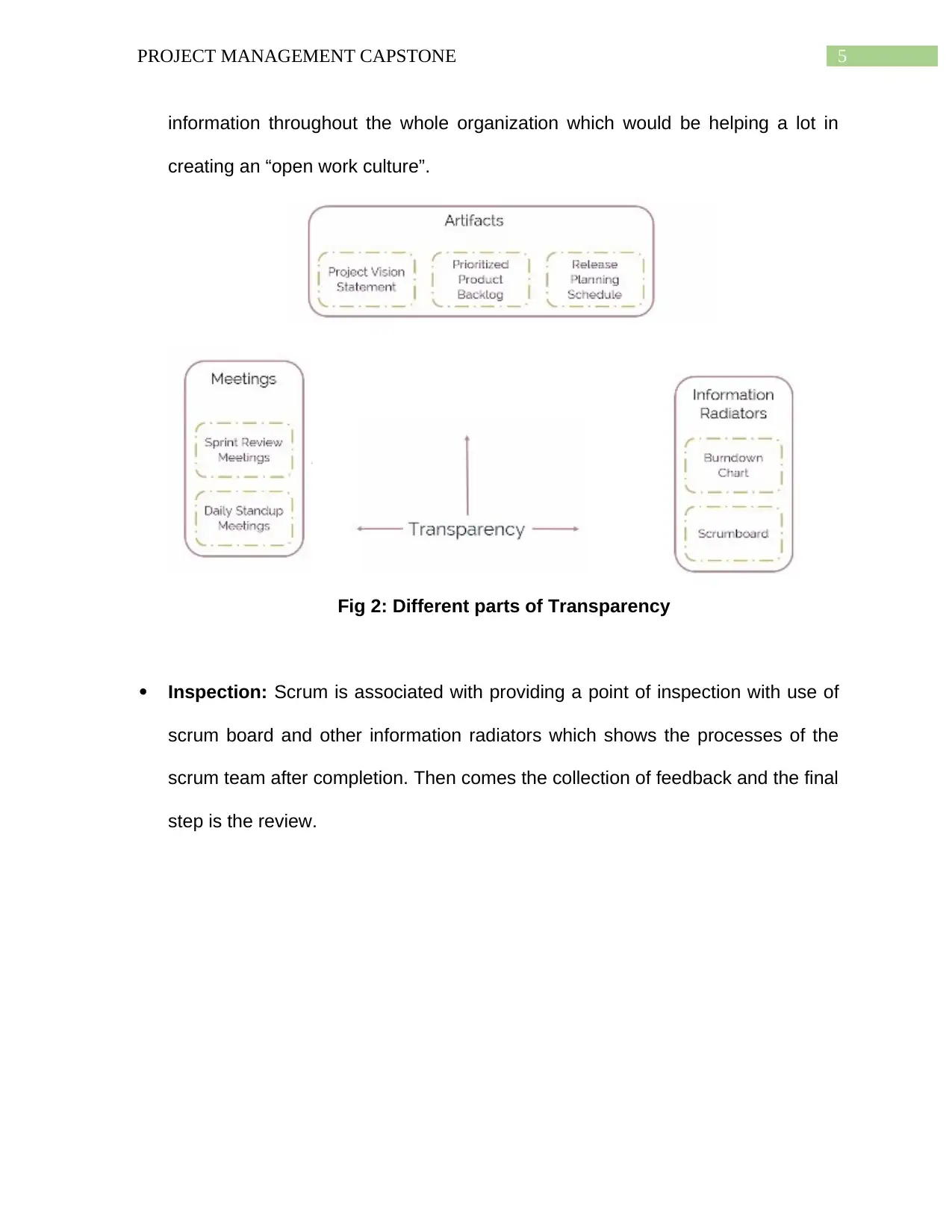
5PROJECT MANAGEMENT CAPSTONE
information throughout the whole organization which would be helping a lot in
creating an “open work culture”.
Fig 2: Different parts of Transparency
Inspection: Scrum is associated with providing a point of inspection with use of
scrum board and other information radiators which shows the processes of the
scrum team after completion. Then comes the collection of feedback and the final
step is the review.
information throughout the whole organization which would be helping a lot in
creating an “open work culture”.
Fig 2: Different parts of Transparency
Inspection: Scrum is associated with providing a point of inspection with use of
scrum board and other information radiators which shows the processes of the
scrum team after completion. Then comes the collection of feedback and the final
step is the review.
⊘ This is a preview!⊘
Do you want full access?
Subscribe today to unlock all pages.

Trusted by 1+ million students worldwide
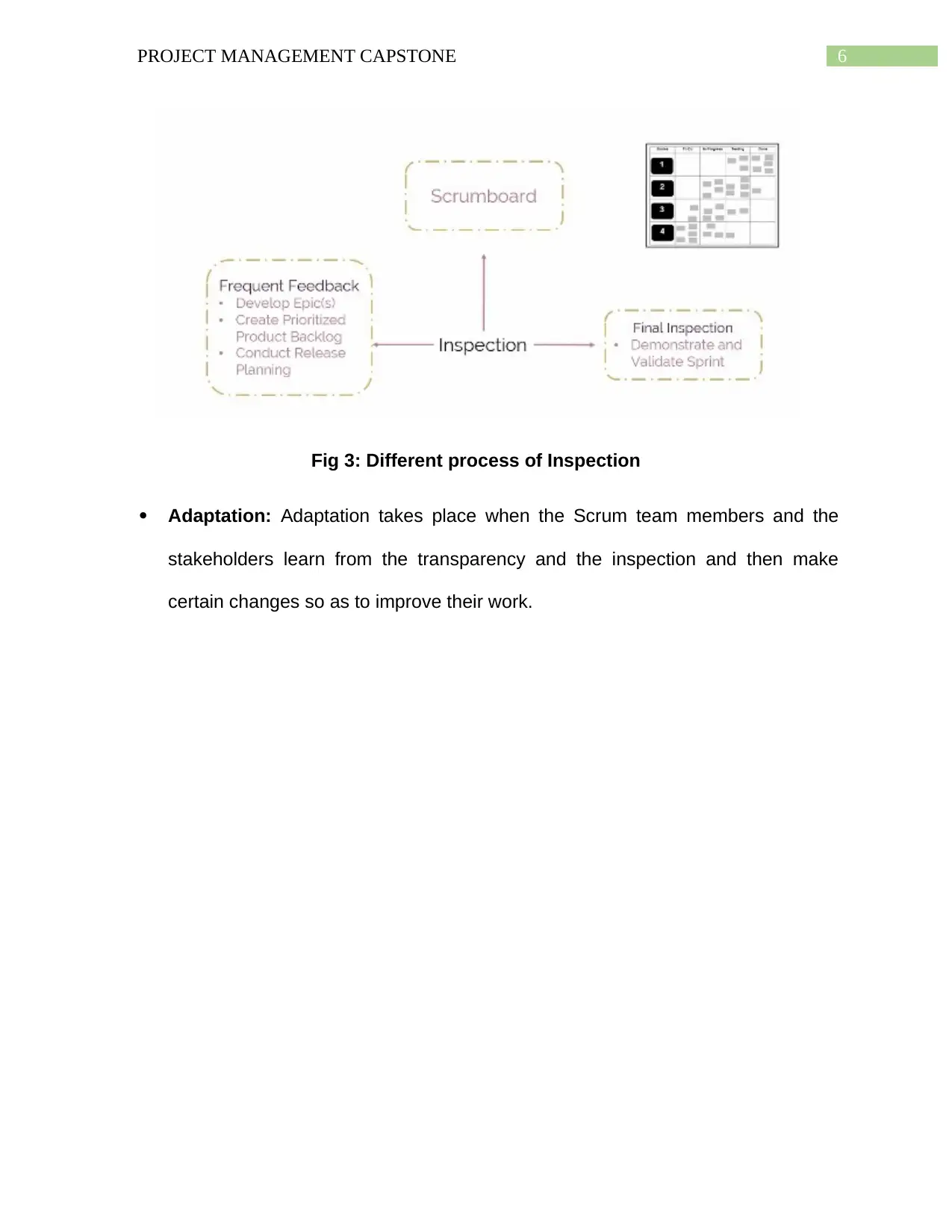
6PROJECT MANAGEMENT CAPSTONE
Fig 3: Different process of Inspection
Adaptation: Adaptation takes place when the Scrum team members and the
stakeholders learn from the transparency and the inspection and then make
certain changes so as to improve their work.
Fig 3: Different process of Inspection
Adaptation: Adaptation takes place when the Scrum team members and the
stakeholders learn from the transparency and the inspection and then make
certain changes so as to improve their work.
Paraphrase This Document
Need a fresh take? Get an instant paraphrase of this document with our AI Paraphraser
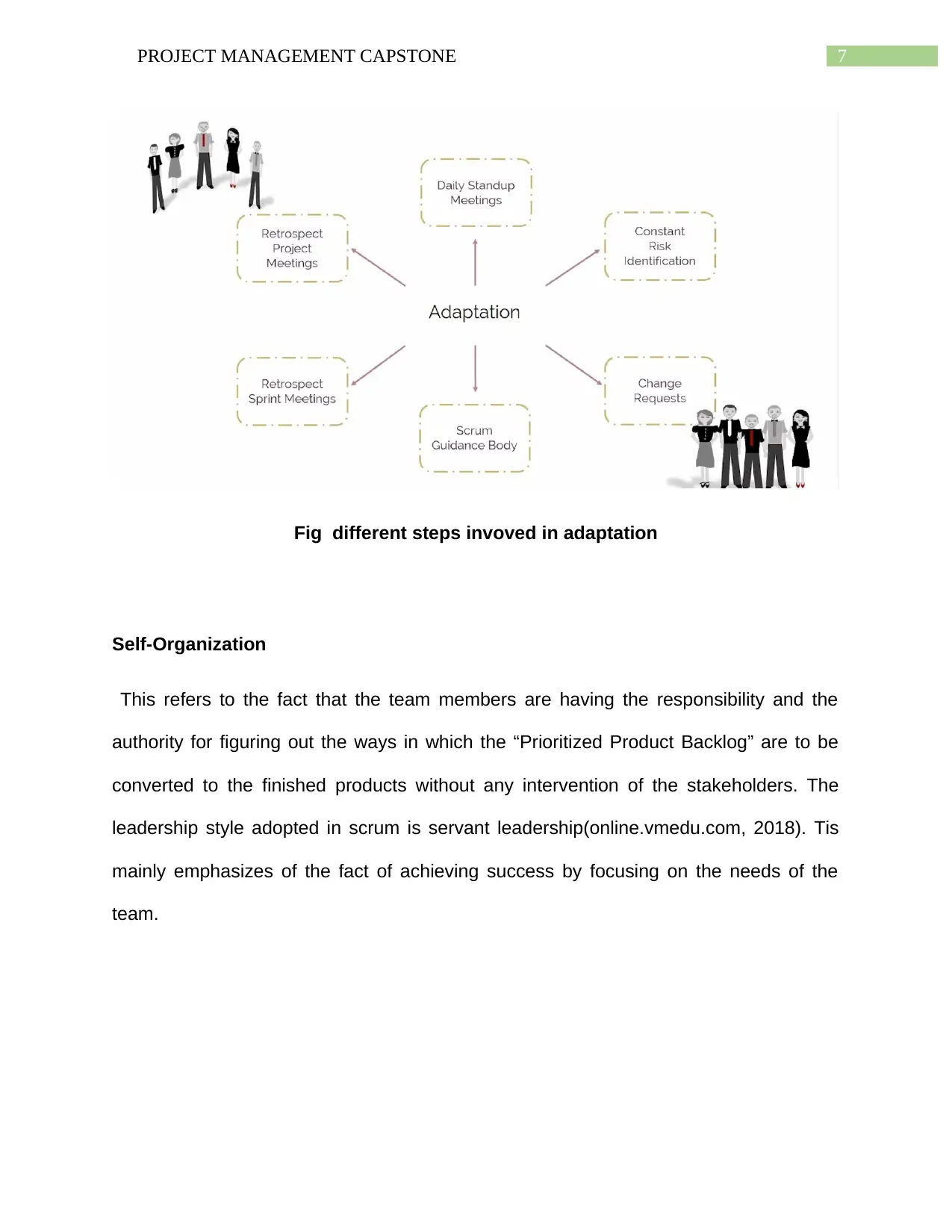
7PROJECT MANAGEMENT CAPSTONE
Fig different steps invoved in adaptation
Self-Organization
This refers to the fact that the team members are having the responsibility and the
authority for figuring out the ways in which the “Prioritized Product Backlog” are to be
converted to the finished products without any intervention of the stakeholders. The
leadership style adopted in scrum is servant leadership(online.vmedu.com, 2018). Tis
mainly emphasizes of the fact of achieving success by focusing on the needs of the
team.
Fig different steps invoved in adaptation
Self-Organization
This refers to the fact that the team members are having the responsibility and the
authority for figuring out the ways in which the “Prioritized Product Backlog” are to be
converted to the finished products without any intervention of the stakeholders. The
leadership style adopted in scrum is servant leadership(online.vmedu.com, 2018). Tis
mainly emphasizes of the fact of achieving success by focusing on the needs of the
team.
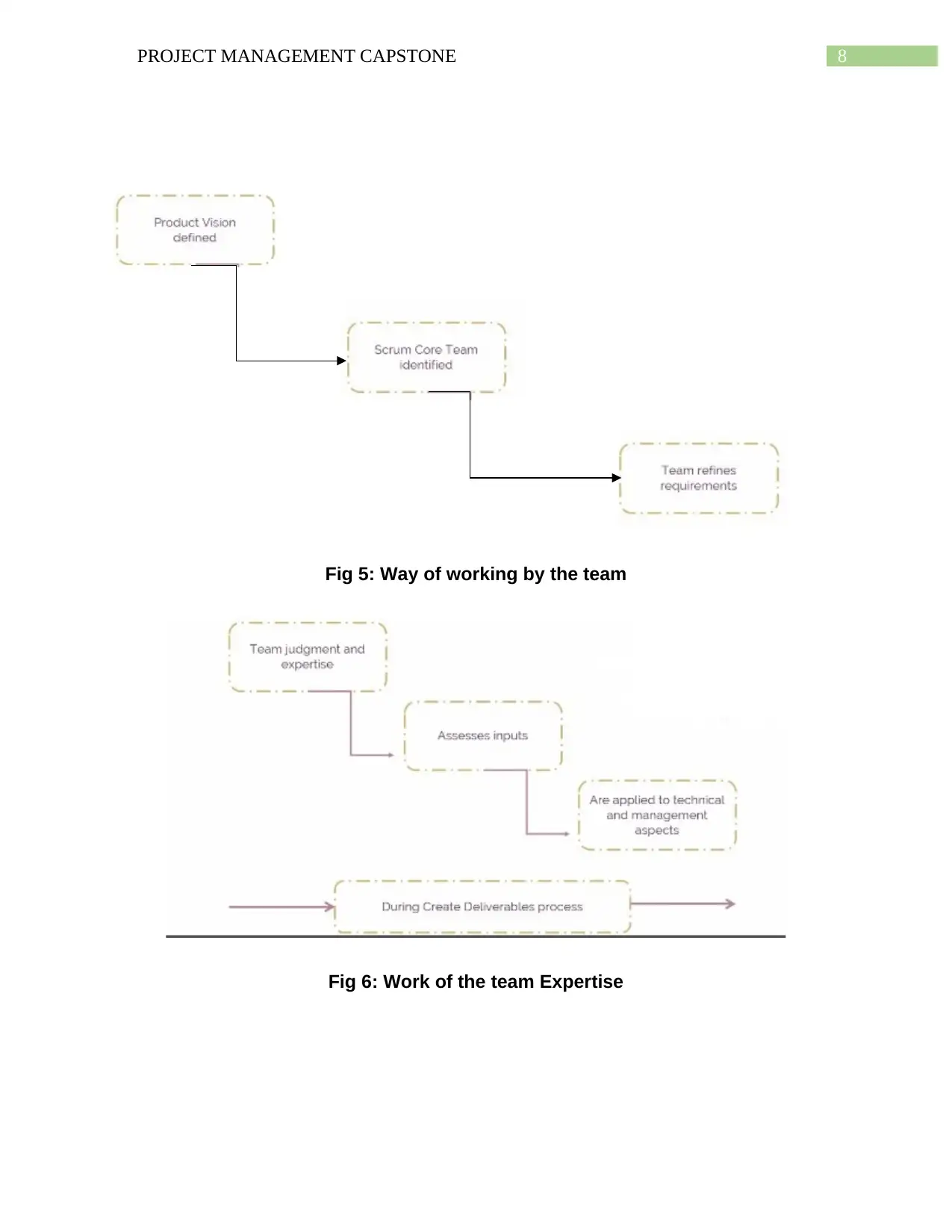
8PROJECT MANAGEMENT CAPSTONE
Fig 5: Way of working by the team
Fig 6: Work of the team Expertise
Fig 5: Way of working by the team
Fig 6: Work of the team Expertise
⊘ This is a preview!⊘
Do you want full access?
Subscribe today to unlock all pages.

Trusted by 1+ million students worldwide
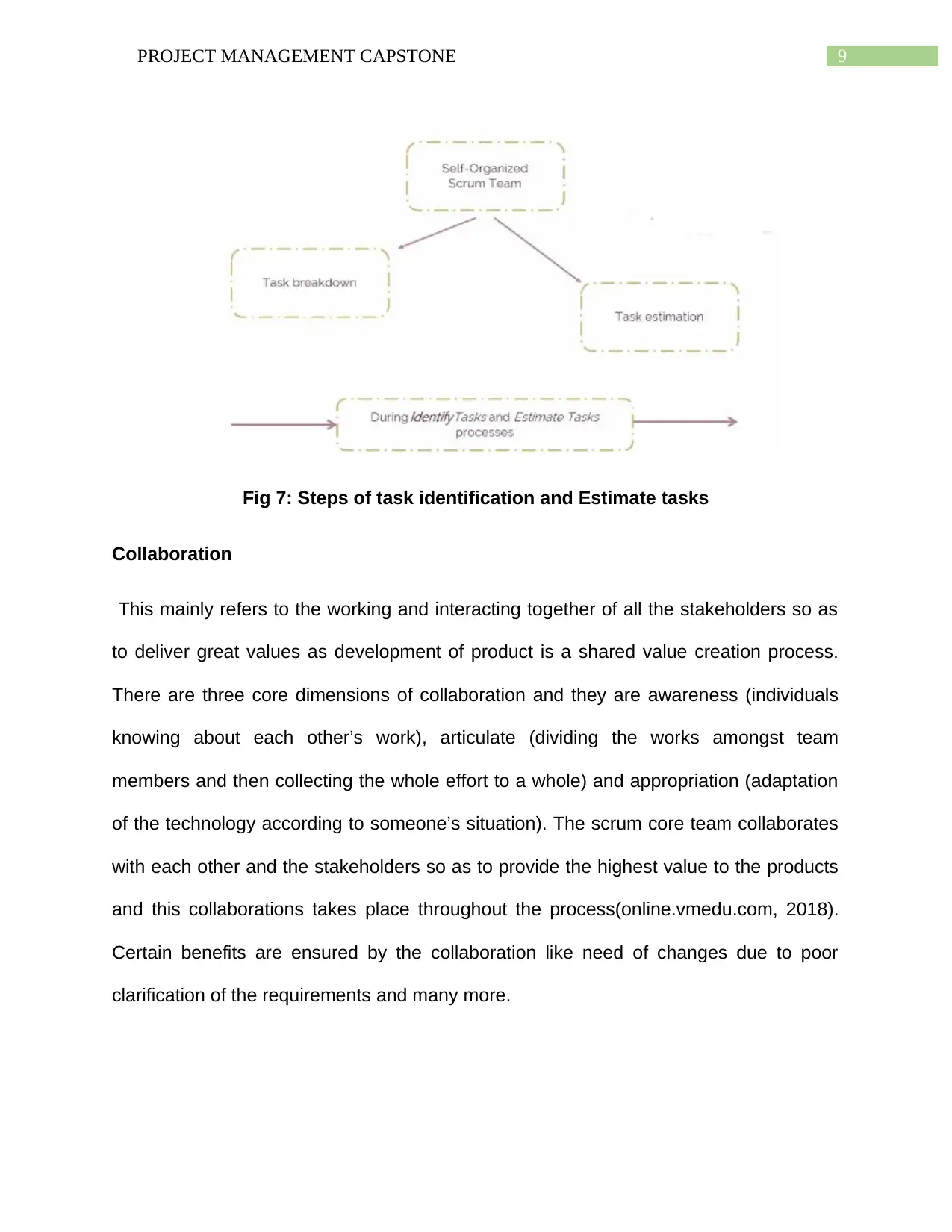
9PROJECT MANAGEMENT CAPSTONE
Fig 7: Steps of task identification and Estimate tasks
Collaboration
This mainly refers to the working and interacting together of all the stakeholders so as
to deliver great values as development of product is a shared value creation process.
There are three core dimensions of collaboration and they are awareness (individuals
knowing about each other’s work), articulate (dividing the works amongst team
members and then collecting the whole effort to a whole) and appropriation (adaptation
of the technology according to someone’s situation). The scrum core team collaborates
with each other and the stakeholders so as to provide the highest value to the products
and this collaborations takes place throughout the process(online.vmedu.com, 2018).
Certain benefits are ensured by the collaboration like need of changes due to poor
clarification of the requirements and many more.
Fig 7: Steps of task identification and Estimate tasks
Collaboration
This mainly refers to the working and interacting together of all the stakeholders so as
to deliver great values as development of product is a shared value creation process.
There are three core dimensions of collaboration and they are awareness (individuals
knowing about each other’s work), articulate (dividing the works amongst team
members and then collecting the whole effort to a whole) and appropriation (adaptation
of the technology according to someone’s situation). The scrum core team collaborates
with each other and the stakeholders so as to provide the highest value to the products
and this collaborations takes place throughout the process(online.vmedu.com, 2018).
Certain benefits are ensured by the collaboration like need of changes due to poor
clarification of the requirements and many more.
Paraphrase This Document
Need a fresh take? Get an instant paraphrase of this document with our AI Paraphraser
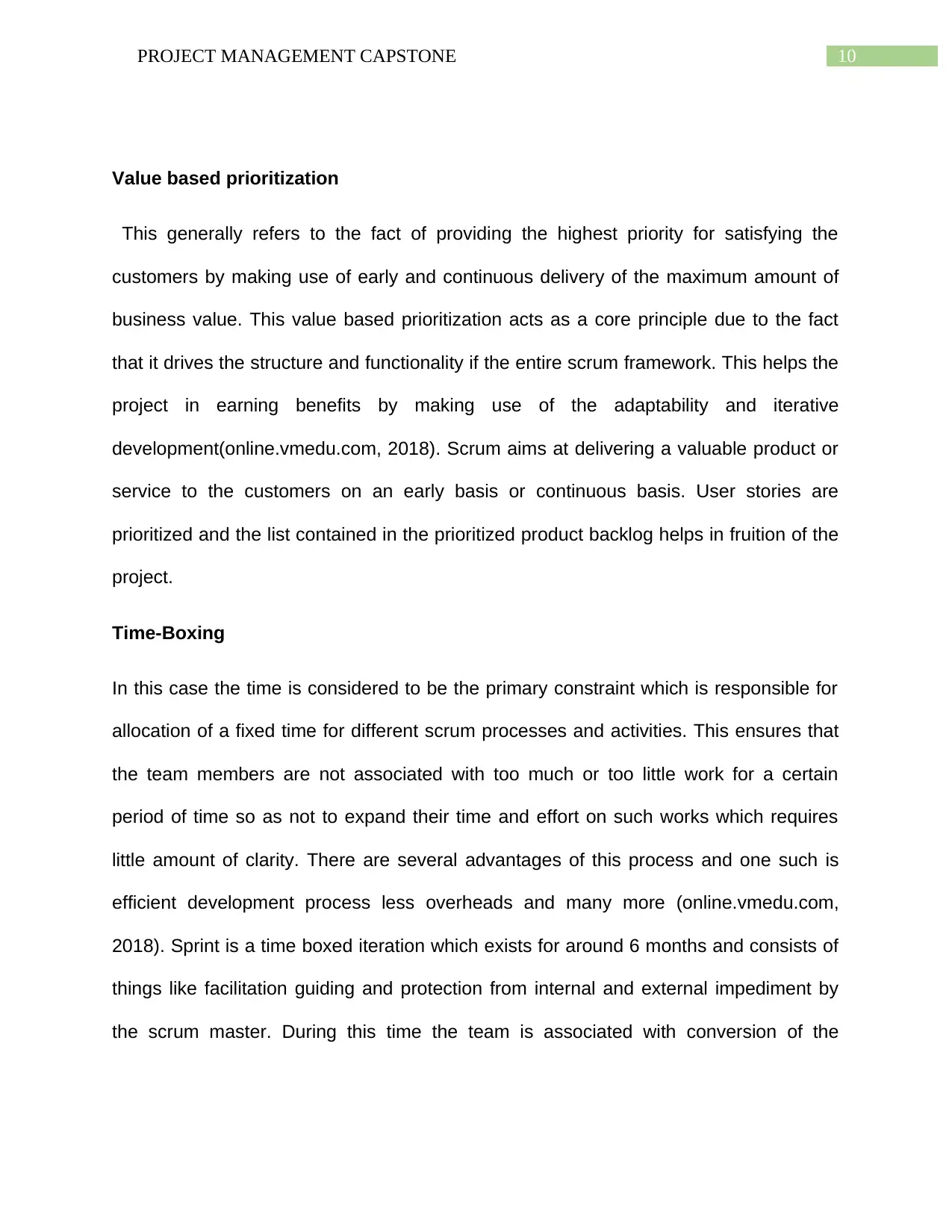
10PROJECT MANAGEMENT CAPSTONE
Value based prioritization
This generally refers to the fact of providing the highest priority for satisfying the
customers by making use of early and continuous delivery of the maximum amount of
business value. This value based prioritization acts as a core principle due to the fact
that it drives the structure and functionality if the entire scrum framework. This helps the
project in earning benefits by making use of the adaptability and iterative
development(online.vmedu.com, 2018). Scrum aims at delivering a valuable product or
service to the customers on an early basis or continuous basis. User stories are
prioritized and the list contained in the prioritized product backlog helps in fruition of the
project.
Time-Boxing
In this case the time is considered to be the primary constraint which is responsible for
allocation of a fixed time for different scrum processes and activities. This ensures that
the team members are not associated with too much or too little work for a certain
period of time so as not to expand their time and effort on such works which requires
little amount of clarity. There are several advantages of this process and one such is
efficient development process less overheads and many more (online.vmedu.com,
2018). Sprint is a time boxed iteration which exists for around 6 months and consists of
things like facilitation guiding and protection from internal and external impediment by
the scrum master. During this time the team is associated with conversion of the
Value based prioritization
This generally refers to the fact of providing the highest priority for satisfying the
customers by making use of early and continuous delivery of the maximum amount of
business value. This value based prioritization acts as a core principle due to the fact
that it drives the structure and functionality if the entire scrum framework. This helps the
project in earning benefits by making use of the adaptability and iterative
development(online.vmedu.com, 2018). Scrum aims at delivering a valuable product or
service to the customers on an early basis or continuous basis. User stories are
prioritized and the list contained in the prioritized product backlog helps in fruition of the
project.
Time-Boxing
In this case the time is considered to be the primary constraint which is responsible for
allocation of a fixed time for different scrum processes and activities. This ensures that
the team members are not associated with too much or too little work for a certain
period of time so as not to expand their time and effort on such works which requires
little amount of clarity. There are several advantages of this process and one such is
efficient development process less overheads and many more (online.vmedu.com,
2018). Sprint is a time boxed iteration which exists for around 6 months and consists of
things like facilitation guiding and protection from internal and external impediment by
the scrum master. During this time the team is associated with conversion of the
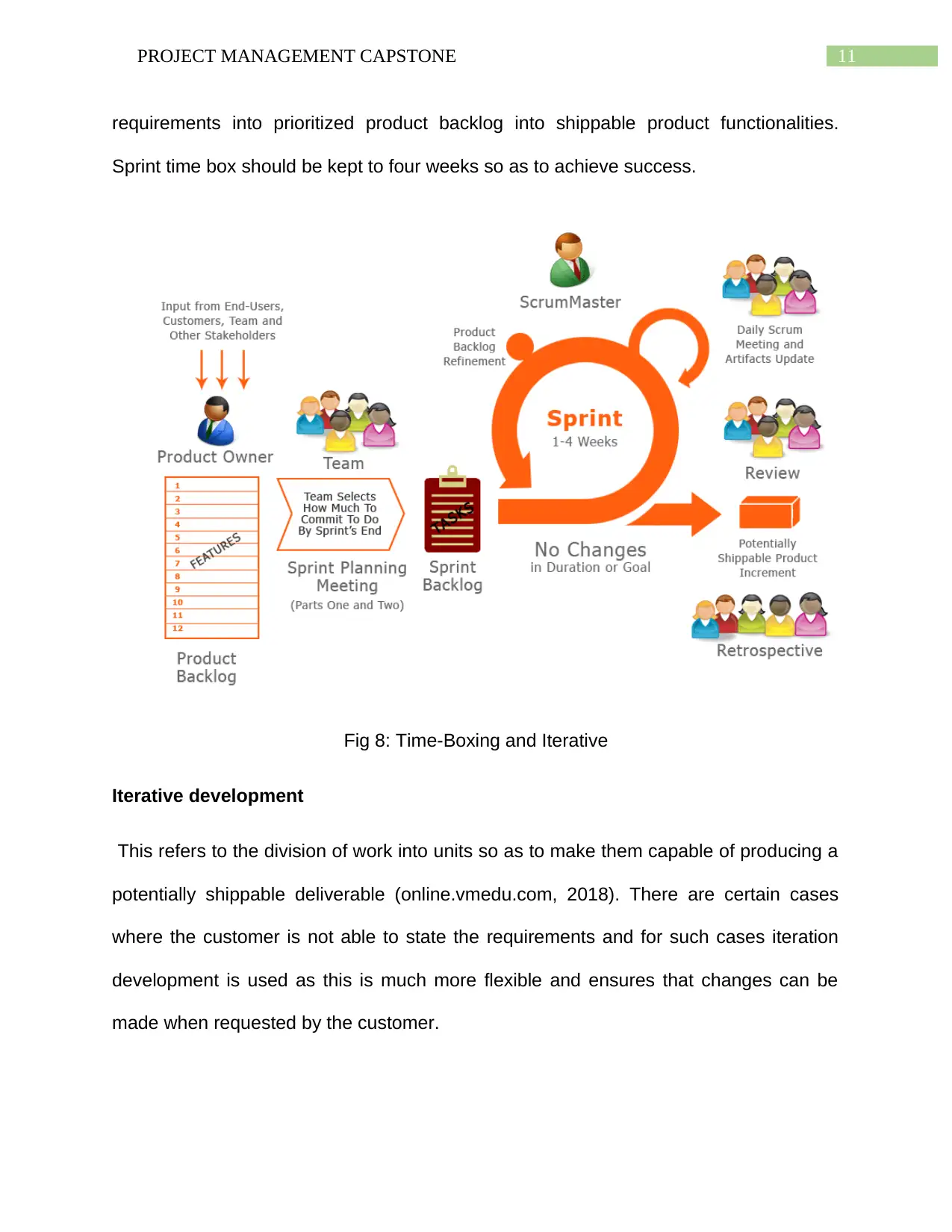
11PROJECT MANAGEMENT CAPSTONE
requirements into prioritized product backlog into shippable product functionalities.
Sprint time box should be kept to four weeks so as to achieve success.
Fig 8: Time-Boxing and Iterative
Iterative development
This refers to the division of work into units so as to make them capable of producing a
potentially shippable deliverable (online.vmedu.com, 2018). There are certain cases
where the customer is not able to state the requirements and for such cases iteration
development is used as this is much more flexible and ensures that changes can be
made when requested by the customer.
requirements into prioritized product backlog into shippable product functionalities.
Sprint time box should be kept to four weeks so as to achieve success.
Fig 8: Time-Boxing and Iterative
Iterative development
This refers to the division of work into units so as to make them capable of producing a
potentially shippable deliverable (online.vmedu.com, 2018). There are certain cases
where the customer is not able to state the requirements and for such cases iteration
development is used as this is much more flexible and ensures that changes can be
made when requested by the customer.
⊘ This is a preview!⊘
Do you want full access?
Subscribe today to unlock all pages.

Trusted by 1+ million students worldwide
1 out of 24
Related Documents
Your All-in-One AI-Powered Toolkit for Academic Success.
+13062052269
info@desklib.com
Available 24*7 on WhatsApp / Email
![[object Object]](/_next/static/media/star-bottom.7253800d.svg)
Unlock your academic potential
Copyright © 2020–2025 A2Z Services. All Rights Reserved. Developed and managed by ZUCOL.




